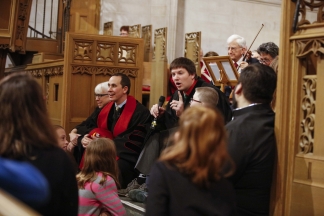news article
What are the five markers of vitality?
May 16, 2018 / By Shannon Hodson / .(JavaScript must be enabled to view this email address)
Editor's Note: This article originally appeared in Spring 2018 issue of the Advocate, which focused on developing vital congregations.
Through the study of thousands of congregations in various contexts, there are five markers that have been consistent with high-vitality congregations:
Inviting and Inspiring Worship
Weekly worship services continue to be a primary place of connection with those who are already connected with the church as well as those who are not yet part of the church. With that in mind, attention should be given to offering a worship experience that moves beyond simply covering the basics of tradition and practice. This involves creating an environment where people feel invited either by a person already attending or the Holy Spirit.
Vital worship can engage a person on a visceral and emotive level. It is relevant and includes high-quality preaching. In short, vital worship is done with excellence.
New and Growing Disciples
Vital congregations are congregations that are making new disciples as well as growing disciples into a deeper relationship with Jesus. Congregations that have a high level of vitality have an intentional plan in place, and actively, to help people become followers of Jesus as well as grow through the sanctifying grace of God through Jesus Christ.
In short, vital congregations are places where people are invited to encounter the grace of God in its fullness.
Small Groups
Small groups in vital congregations are employed for faith formation, accountability, and encouragement. Utilizing classic Wesleyan questions such as the condition of a person’s soul and areas of struggle and sin. Small groups provide an opportunity to live life deeply together and provide opportunity to invite others deeper into the grace of God found in Jesus.
As congregations grow numerically, small groups are essential for connection and care in the life of the congregation. The rate at which a congregation can grow numerically and remain healthy and vital is in direct relationship to the quantity and quality of small groups.
Engaged Disciples in Mission and Outreach
Vital congregations live out a faith that is actively partnering with God to be agents of transformation in the world. Engagement is through hands-on activity outside the bounds of the local congregation. This is seen through activity in local, national, and international mission and outreach.
Movement is made beyond charitable support such as food and clothing pantries, toward a deeper relationship with Jesus and the church.
Generous Giving
Vital congregations have healthy, biblical, and consistent conversations about a person’s relationship with God and money. Healthy conversations leads to participants of the congregation giving generously financially as well as with other resources. Significant numbers of people will report engaging the spiritual discipline of tithing. Additionally, congregations will provide financial assistance to mission and outreach locally, nationally, and internationally. Vital congregations have an outflow of financial resources.
Following are profiles of five congregations that have been recognized for strength in a marker. The pastors of these congregations explain how intentional focus on the marker helped increase the vitality of their church.